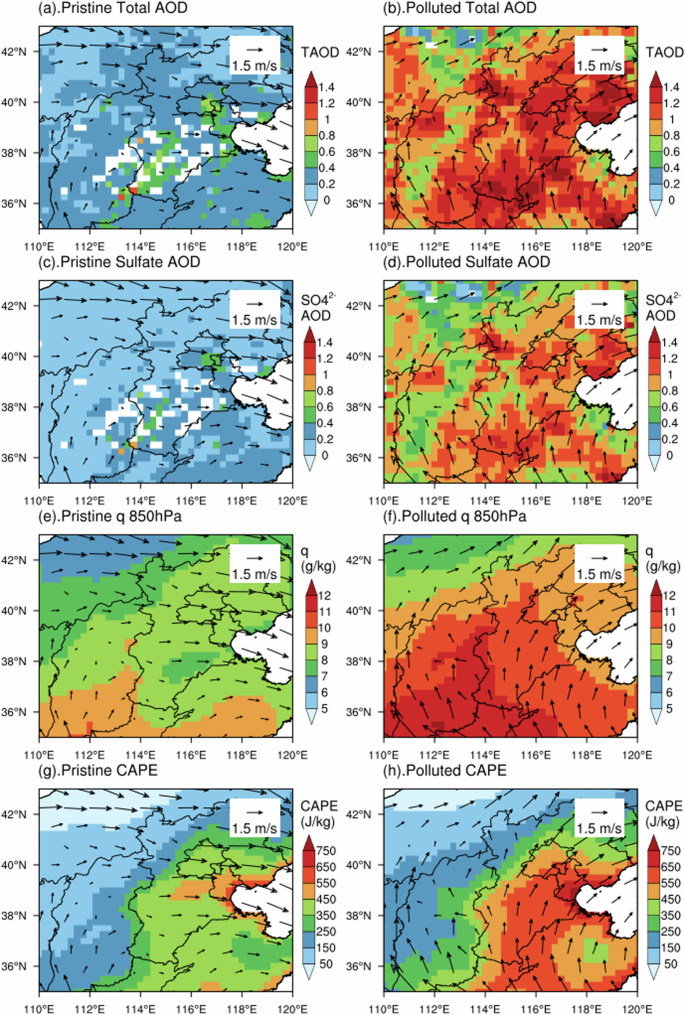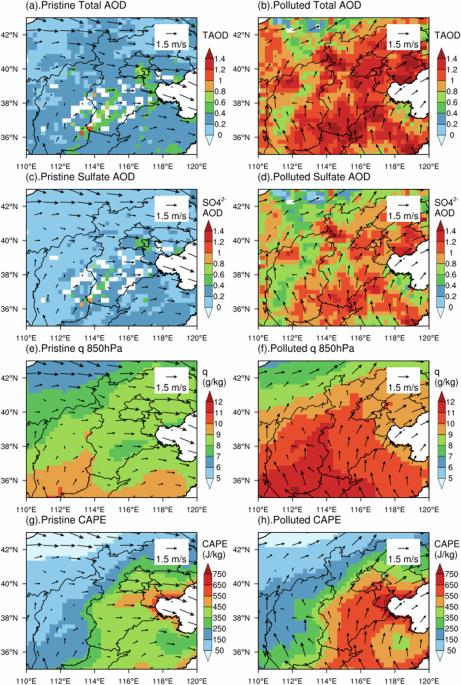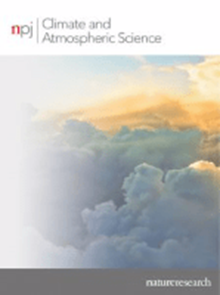Complex interplay of sulfate aerosols and meteorology conditions on precipitation and latent heat vertical structure
IF 8.4
1区 地球科学
Q1 METEOROLOGY & ATMOSPHERIC SCIENCES
引用次数: 0
Abstract
An eight-year satellite observation dataset reveals that sulfate aerosols significantly influence the vertical structure of precipitation and latent heat (LH) in the Beijing-Tianjin-Hebei (BTH) region during summer. In this period, prevalent sulfate aerosols combine with warm, humid southerly winds and elevated convective available potential energy (CAPE), influencing precipitation dynamics. Under polluted conditions with specific CAPE and precipitation top temperature (PTT) ranges, precipitation particles experience accelerated growth within the mixed-phase layer, delineated by the −5 °C to 2 °C isotherms, compared to pristine environments. This results in a marked increase in both the intensity and height at which the maximum LH is released. Subsequent analysis reveals that hygroscopic sulfate aerosols, acting as cloud condensation nuclei (CCN), amplify the collision-coalescence process within the mixed layer amid high cloud water content, propelling rapid precipitation particle growth and elevating the PTT. This warming effect surpasses the cooling contribution from robust CAPE, culminating in a net elevation of PTT under polluted scenarios compared to pristine ones. Additionally, quantification of PTT sensitivity to both CAPE and aerosol optical depth (AOD) unveils a high consistency between satellite-detected PTT responses to CAPE and those predicted by cloud-resolving model simulations. The study deduces that the role of aerosols as CCN in either invigorating or diminishing the collision-coalescence process is contingent on the available cloud water.


硫酸盐气溶胶和气象条件对降水和潜热垂直结构的复杂相互作用
八年的卫星观测数据集显示,硫酸盐气溶胶对京津冀(BTH)地区夏季降水和潜热(LH)的垂直结构有显著影响。在此期间,普遍存在的硫酸盐气溶胶与温暖潮湿的偏南风和升高的对流可用势能(CAPE)相结合,对降水动态产生影响。在具有特定 CAPE 和降水顶温 (PTT) 范围的污染条件下,降水颗粒在混合相层(由 -5 °C 至 2 °C 等温线划定)内的生长速度比原始环境要快。这导致释放最大 LH 的强度和高度明显增加。随后的分析表明,吸湿性硫酸盐气溶胶作为云凝结核(CCN),在云水含量较高的情况下放大了混合层内的碰撞-凝聚过程,推动了降水粒子的快速增长并提高了 PTT。这种升温效应超过了强劲的 CAPE 带来的降温效应,最终导致在污染情况下 PTT 比原始情况下净升高。此外,通过量化 PTT 对 CAPE 和气溶胶光学深度(AOD)的敏感性,发现卫星探测到的 PTT 对 CAPE 的响应与云解析模式模拟预测的响应高度一致。研究推断,气溶胶作为 CCN 在激活或减弱碰撞-凝聚过程中的作用取决于可用的云水。
本文章由计算机程序翻译,如有差异,请以英文原文为准。
求助全文
约1分钟内获得全文
求助全文
来源期刊

npj Climate and Atmospheric Science
Earth and Planetary Sciences-Atmospheric Science
CiteScore
8.80
自引率
3.30%
发文量
87
审稿时长
21 weeks
期刊介绍:
npj Climate and Atmospheric Science is an open-access journal encompassing the relevant physical, chemical, and biological aspects of atmospheric and climate science. The journal places particular emphasis on regional studies that unveil new insights into specific localities, including examinations of local atmospheric composition, such as aerosols.
The range of topics covered by the journal includes climate dynamics, climate variability, weather and climate prediction, climate change, ocean dynamics, weather extremes, air pollution, atmospheric chemistry (including aerosols), the hydrological cycle, and atmosphere–ocean and atmosphere–land interactions. The journal welcomes studies employing a diverse array of methods, including numerical and statistical modeling, the development and application of in situ observational techniques, remote sensing, and the development or evaluation of new reanalyses.
 求助内容:
求助内容: 应助结果提醒方式:
应助结果提醒方式:


